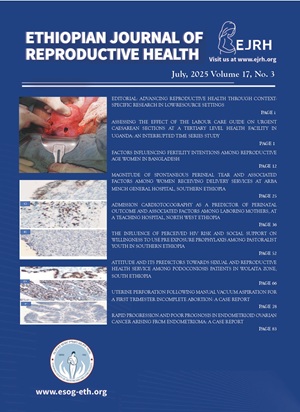Factors Influencing Fertility Intentions Among Working and Non-Working Women in Bangladesh
DOI:
https://doi.org/10.69614/ejrh.v17i3.901Abstract
Our study aimed to examine the desire for having more children and its determinants among childbearing women in Bangladesh due to dearth of sufficient data of this region. Here a secondary data analysis was done on 2017 Bangladesh Demographic and Health Survey/BDHS. A total of 20,127 fertile, married, and sexually active women were included this study. Multilevel mixed-effect logistic regression model was done to show association between fertility desire and explanatory variables. In Bangladesh, 26.5% of working and non-working women expressed a wish for more children. It was discovered that women between the ages of 15 and 24 (66.6%), the richest women (29.6%), women with higher education levels (46.6%), urban residents (27.4%), women who had their first cohabitation at the age of ?25 (42.8%), women who used contraceptives (32.8%), and women who had at most two ideal children had higher intention of being fertile (27.1%). Compared to women with 1-2 children (41.2%) or 3+ children (24.4%), those with a greater number of living children showed significantly higher intention (80%). Compared to those whose spouses were less educated or worked in agriculture, women whose husbands held non-agricultural jobs (29.6%) or higher education (36.1%) expressed greater intention of having child. We found that the overall desire for having more children among Bangladeshi women was influenced significantly by socio-economic and demographic characteristics such as age, education, wealth, age at first cohabitation, contraceptive use and many more. Specific public health interventions on fertility rate control existant in Bangladesh ought to critically count these factors.
References
B. Tsegaye Negash, “Fertility intention among married women in Ethiopia: a multilevel analysis of Ethiopian demographic health survey 2016,” Contracept Reprod Med, vol. 8, no. 1, Jan. 2023, doi: 10.1186/s40834-022-00201-z.
E. K. Odusinaet al., “Fertility preferences among couples in Nigeria: A cross sectional study,” Reprod Health, vol. 17, no. 1, Jun. 2020, doi:10.1186/s12978-020-00940-9.
G. W. Jones, P. Tay. Straughan, and A. W. Ming. Chan, “Very low fertility in Pacific Asian countries: Causes and policy responses,” pp. 19–40, Sep. 2008, doi: 10.4324/9780203890066-9.
“World Fertility Rate 1950-2024 | MacroTrends.” Accessed: Mar. 16, 2024. [Online]. Available: https://www.macrotrends.net/global-metrics/countries/IRL/world/fertility-rate
Md. R. Alam, Md. A. Rahman, and Y. Sawangdee, “Factors Influencing the Number of Children Born to Working Women in Bangladesh: A Population-Based Study,” J PediatrPerinatol Child Health, vol. 06, no. 04, 2022, doi: 10.26502/jppch.74050133.
“Fertility rate in Asia | TheGlobalEconomy.com.” Accessed: Jan. 28, 2024. [Online]. Available: https://www.theglobaleconomy.com/rankings/fertility_rate/Asia/
G. P. Dahal, S. S. Padmadas, and P. R. A. Hinde, “Fertility-Limiting Behavior and Contraceptive Choice among Men in Nepal,” 2008. [Online]. Available: https://www.jstor.org/stable/30039252
T. Wang, C. Wang, Y. Zhou, W. Zhou, and Y. Luo, “Fertility intentions for a second child among urban working women with one child in Hunan Province, China: a cross-sectional study,” Public Health, vol. 173, pp. 21–28, Aug. 2019, doi: 10.1016/j.puhe.2019.05.006.
B. O. Ahinkorah, A. A. Seidu, E. K. Armah-Ansah, E. K. Ameyaw, E. Budu, and S. Yaya, “Socio-economic and demographic factors associated with fertility preferences among women of reproductive age in Ghana: evidence from the 2014 Demographic and Health Survey,” Reprod Health, vol. 18, no. 1, Dec. 2021, doi: 10.1186/s12978-020-01057-9.
M. W. Muluneh and Y. A. Moyehodie, “Determinants of desire for more children among women in Ethiopia,” BMC Womens Health, vol. 21, no. 1, Dec. 2021, doi: 10.1186/s12905-021-01563-3.
Q. H. Ashraf, D. N. Weil, and J. Wilde, “The Effect of Fertility Reduction on Economic Growth,” Popul Dev Rev, vol. 39, no. 1, pp. 97–130, Mar. 2013, doi: 10.1111/J.1728-4457.2013.00575.X.
C. F. Westoff, “DHS COMPARATIVE REPORTS 25,” 2000, Accessed: Jan. 27, 2024. [Online]. Available: www.measuredhs.com
A. A. Creanga, D. Gillespie, S. Karklins, and A. O. Tsui, “Low use of contraception among poor women in Africa: an equity issue,” Bull World Health Organ, vol. 89, no. 4, pp. 258–266, Apr. 2011, doi: 10.2471/BLT.10.083329.
J. K. B. Matovu, F. Makumbi, R. K. Wanyenze, and D. Serwadda, “Determinants of fertility desire among married or cohabiting individuals in Rakai, Uganda: a cross-sectional study,” Reprod Health, vol. 14, no. 1, Jan. 2017, doi: 10.1186/S12978-016-0272-3.
M. Garenne, “Trends in marriage and contraception in sub-Saharan Africa: A longitudinal perspective on factors of fertility decline.” Jan. 01, 2014. Accessed: Jan. 28, 2024. [Online]. Available: https://dhsprogram.com/publications/publication-as42-analytical-studies.cfm
F. Niragire, C. Ndikumana, M. G. Nyirahabimana, and D. Uwizeye, “Prevalence and factors associated with fertility desire among HIV-positive women in Rwanda in the context of improved life expectancy,” Archives of Public Health, vol. 79, no. 1, Dec. 2021, doi: 10.1186/s13690-021-00742-w.
B. O. Ahinkorahet al., “Which factors predict fertility intentions of married men and women? Results from the 2012 Niger Demographic and Health Survey,” PLoS ONE, vol. 16, no. 6 June. Public Library of Science, Jun. 01, 2021. doi: 10.1371/journal.pone.0252281.
B. O. Ahinkorahet al., “Drivers of desire for more children among childbearing women in sub-Saharan Africa: implications for fertility control,” BMC Pregnancy Childbirth, vol. 20, no. 1, Dec. 2020, doi: 10.1186/s12884-020-03470-1.
G. Rutaremwa, J. Galande, H. L. Nviiri, E. Akiror, and T. Jhamba, “The contribution of contraception, marriage and postpartum insusceptibility to fertility levels in Uganda: an application of the aggregate fertility model,” Fertil Res Pract, vol. 1, no. 1, Dec. 2015, doi: 10.1186/S40738-015-0009-Y.
T. Laelago, Y. Habtu, and S. Yohannes, “Proximate determinants of fertility in Ethiopia; an application of revised Bongaarts model,” Reprod Health, vol. 16, no. 1, Feb. 2019, doi: 10.1186/S12978-019-0677-X.
S. Mahmud, N. M. Shah, and S. Becker, “Measurement of Women’s Empowerment in Rural Bangladesh,” World Dev, vol. 40, no. 3, pp. 610–619, Mar. 2012, doi: 10.1016/J.WORLDDEV.2011.08.003.
A. Ogaboh, E. M. Ushie, and F. M. Attah, “Socio-cultural and economic determinants of fertility differentials in rural and urban Cross Rivers State, Nigeria,” 2011, Accessed: Jan. 27, 2024. [Online]. Available: http://www.academicjournals.org/JGRP
I. A. Ifelunini, S. C. Ugwu, H. E. Ichoku, A. N. Omeje, and E. Ihim, “Determinants of fertility rate among women in Ghana and Nigeria: Implications for population growth and sustainable development,” African Population Studies, vol. 32, no. 2, pp. 4125–4133, Sep. 2018, doi: 10.11564/32-2-1188.
“(PDF) Modeling the Determinants of Fertility among Women of Childbearing Age in Nigeria: Analysis Using Generalized Linear Modeling Approach.” Accessed: Jan. 28, 2024. [Online]. Available: https://www.researchgate.net/publication/327208425_Modeling_the_Determinants_of_Fertility_among_Women_of_Childbearing_Age_in_Nigeria_Analysis_Using_Generalized_Linear_Modeling_Approach
L. Jiang and K. Hardee, “Women’s Education, Family Planning, or Both? Application of Multistate Demographic Projections in India,” Int J Popul Res, vol. 2014, pp. 1–9, Jan. 2014, doi: 10.1155/2014/940509.
F. Götmark and M. Andersson, “Human fertility in relation to education, economy, religion, contraception, and family planning programs,” BMC Public Health, vol. 20, no. 1, Feb. 2020, doi: 10.1186/S12889-020-8331-7.
S. KC and W. Lutz, “The human core of the shared socioeconomic pathways: Population scenarios by age, sex and level of education for all countries to 2100,” Glob Environ Change, vol. 42, pp. 181–192, Jan. 2017, doi: 10.1016/J.GLOENVCHA.2014.06.004.
Q. Wang and X. Sun, “The Role of Socio-political and Economic Factors in Fertility Decline: A Cross-country Analysis,” World Dev, vol. 87, pp. 360–370, Nov. 2016, doi: 10.1016/j.worlddev.2016.07.004.
K. Wolf and C. H. Mulder, “Comparing the fertility of Ghanaian migrants in Europe with nonmigrants in Ghana,” Popul Space Place, vol. 25, no. 2, Mar. 2019, doi: 10.1002/PSP.2171.
J. C. Caldwell, “Mass education as a determinant of the timing of fertility decline ( world).,” Popul Dev Rev, vol. 6, no. 2, pp. 225–256, 1980, doi: 10.2307/1972729.
J. C. Caldwell, “On net intergenerational wealth flows: An update,” Popul Dev Rev, vol. 31, no. 4, pp. 721–740, Dec. 2005, doi: 10.1111/J.1728-4457.2005.00095.X.
B. O. Ahinkorahet al., “Drivers of desire for more children among childbearing women in sub-Saharan Africa: implications for fertility control,” BMC Pregnancy Childbirth, vol. 20, no. 1, Dec. 2020, doi: 10.1186/S12884-020-03470-1.
X. Yan, J. Du, and G. P. Ji, “Prevalence and factors associated with fertility desire among people living with HIV: A systematic review and meta-analysis,” PLoS One, vol. 16, no. 3, Mar. 2021, doi: 10.1371/JOURNAL.PONE.0248872.
N. S. Aylie, L. S. Dadi, E. Alemayehu, and M. A. Mekonn, “Determinants of Fertility Desire among Women Living with HIV in the Childbearing Age Attending Antiretroviral Therapy Clinic at Jimma University Medical Center, Southwest Ethiopia: A Facility-Based Case-Control Study,” Int J Reprod Med, vol. 2020, pp. 1–10, Aug. 2020, doi: 10.1155/2020/6504567.
S. Babalola, M. E. Figueroa, and S. Krenn, “Association of Mass Media Communication with Contraceptive Use in Sub-Saharan Africa: A Meta-Analysis of Demographic and Health Surveys,” J Health Commun, vol. 22, no. 11, pp. 885–895, Nov. 2017, doi: 10.1080/10810730.2017.1373874.
A. Z. Islam et al., “Prevalence and Determinants of Contraceptive use among Employed and Unemployed Women in Bangladesh,” Int J MCH AIDS, vol. 5, no. 2, p. 92, 2016, doi: 10.21106/IJMA.83.
T. B. Belachew, D. B. Asmamaw, and W. D. Negash, “Short birth interval and its predictors among reproductive age women in high fertility countries in sub-Saharan Africa: a multilevel analysis of recent Demographic and Health Surveys,” BMC Pregnancy Childbirth, vol. 23, no. 1, Dec. 2023, doi: 10.1186/s12884-023-05403-0.
E. Wekesa and E. Coast, “Fertility desires among men and women living with HIV/AIDS in Nairobi slums: a mixed methods study,” PLoS One, vol. 9, no. 8, Aug. 2014, doi: 10.1371/JOURNAL.PONE.0106292.
B. O. Ahinkorahet al., “Drivers of desire for more children among childbearing women in sub-Saharan Africa: implications for fertility control,” BMC Pregnancy Childbirth, vol. 20, no. 1, Dec. 2020, doi: 10.1186/S12884-020-03470-1.
Y. A. Melaku, E. G. Zeleke, J. Kinsman, and A. K. Abraha, “Fertility desire among HIV-positive women in Tigray region, Ethiopia: implications for the provision of reproductive health and prevention of mother-to-child HIV transmission services,” BMC Womens Health, vol. 14, no. 1, 2014, doi: 10.1186/S12905-014-0137-2.
D. Cooper, J. Moodley, V. Zweigenthal, L. G. Bekker, I. Shah, and L. Myer, “Fertility intentions and reproductive health care needs of people living with HIV in Cape Town, South Africa: implications for integrating reproductive health and HIV care services,” AIDS Behav, vol. 13 Suppl 1, no. SUPPL. 1, Jun. 2009, doi: 10.1007/S10461-009-9550-1.
M. Ramos De Souza, W. N. Do Amaral, R. Alves Guimarães, G. Rezza, and S. M. Brunini, “Reproductive desire among women living with HIV/AIDS in Central Brazil: Prevalence and associated factors,” PLoS One, vol. 12, no. 10, Oct. 2017, doi: 10.1371/JOURNAL.PONE.0186267.
B. Mekonnen and A. Minyihun, “Fertility Desire And Associated Factors Among HIV Positive Women Attending ART Clinics In Amhara Region Referral Hospitals In Northwest Ethiopia, 2017,” HIV AIDS (Auckl), vol. 11, pp. 247–254, 2019, doi: 10.2147/HIV.S221941.
“Exploring fertility decisions among pregnant HIV-positive women on antiretroviral therapy at a health centre in Balaka, Malawi: A descriptive qualitative - PubMed.” Accessed: Jan. 28, 2024. [Online]. Available: https://pubmed.ncbi.nlm.nih.gov/26955433/
L. Jiang and K. Hardee, “Women’s Education, Family Planning, or Both? Application of Multistate Demographic Projections in India,” Int J Popul Res, vol. 2014, pp. 1–9, Jan. 2014, doi: 10.1155/2014/940509.
“Women’s education and fertility: results from 26 Demographic and Health Surveys - PubMed.” Accessed: Jan. 28, 2024. [Online]. Available: https://pubmed.ncbi.nlm.nih.gov/7482677/
“(PDF) Preference or Aversion? Exploring Fertility Desires among China’s Young Urban Elite.” Accessed: Jan. 28, 2024. [Online]. Available: https://www.researchgate.net/publication/323749392_Preference_or_Aversion_Exploring_Fertility_Desires_among_China’s_Young_Urban_Elite
W. I. De Silva, “Do fertility intentions and behaviour influence sterilization in Sri Lanka?,” Asia Pac Popul J, vol. 7, no. 4, pp. 1–13, Dec. 1992, doi: 10.18356/B5113213-EN.
“Family size: why some Nigerian men want more children.” Accessed: Mar. 23, 2024. [Online]. Available: https://theconversation.com/family-size-why-some-nigerian-men-want-more-children-159692



